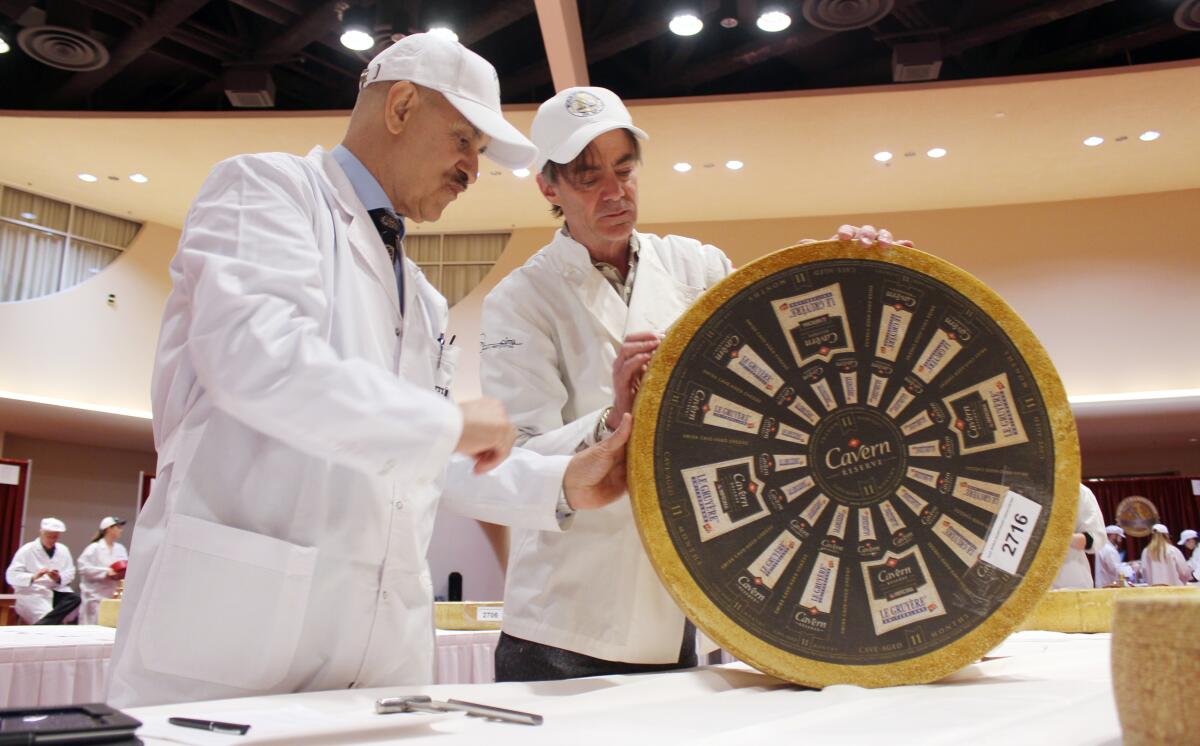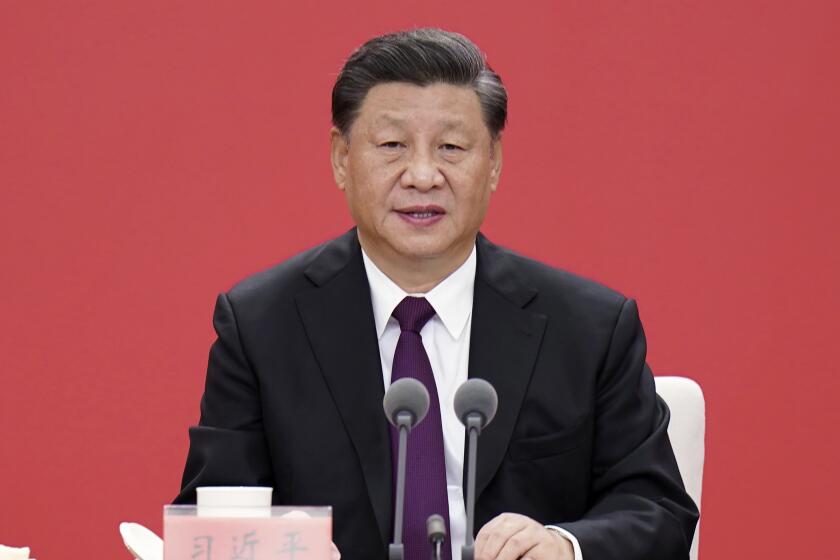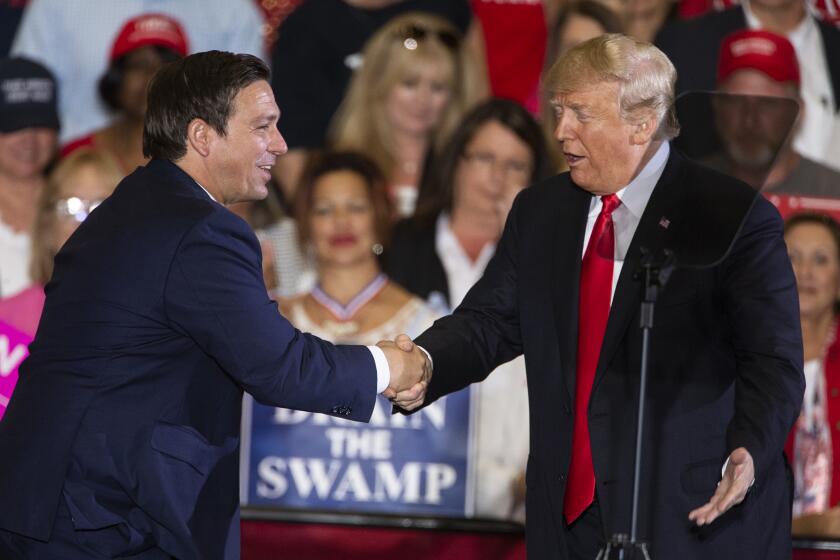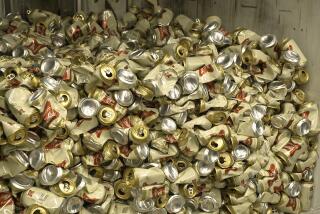Column: Whose cheese is it anyway? The Swiss ponder the international politics of gruyere

- Share via
Switzerland is a small country that is not known for too many things. It’s got its cheese, its banks, its mountains, its neutrality, its watches, its pocketknives and its chocolate.
If any of those is threatened — threatened with cultural appropriation, that is — beware! The Swiss take this stuff seriously.
That’s what accounts for two recent crises, one over the labeling of gruyere cheese and another over the packaging of Toblerone chocolates. (Perhaps you blinked and missed them.)
Let’s start with gruyere.
Opinion Columnist
Nicholas Goldberg
Nicholas Goldberg served 11 years as editor of the editorial page and is a former editor of the Op-Ed page and Sunday Opinion section.
Gruyere is, as the “Oxford Companion to Cheese” puts it, “among the greatest of all cheeses.” It orginated in La Gruyère, a region not far from the French-Swiss border, where it’s been produced for almost 1,000 years. A smooth, mild, hard cheese, it is made from the unpasteurized milk of cows that roam idyllic pastures high in the mountains using rigorous traditional methods passed down through the generations.
But in the last few decades it’s been made elsewhere too. And the Swiss are not happy about it, nor are their neighbors in France.
At issue before the U.S. 4th Circuit Court of Appeals earlier this month was whether American cheese makers in Wisconsin, Idaho and elsewhere are within their rights to make and label cheese under the name gruyere — even though they’ve only been doing so for several decades, they don’t adhere strictly to the traditional process and the cheese they’re selling isn’t from La Gruyère or La Gruyère adjacent.
The Swiss and French cheese makers said, well, of course they’re not. Bien sûr que non!
The Americans, for their part, said the Europeans should chill out and get over themselves. The name gruyere is generic, like bologna or frankfurters.
No one expects bologna to come from Bologna.
The best spin from the 2023 ‘Freedom in the World’ report is that the ongoing decline in rights and liberties is continuing at a slower pace than before.
Now it’s true that this dispute doesn’t have the significance of the war in Ukraine or the gathering climate crisis.
But it captured my attention. Bitter cheese makers fighting an across-the-ocean battle! And there’s a fair amount of cheese at stake. Seven million pounds of gruyere were imported from Switzerland in 2020 and almost 40,000 pounds of French gruyere were sold in the U.S. in 2016, according to the court of appeals. Millions more pounds of so-called gruyere are produced in the U.S.
In the end, the American cheese makers won the day. They convinced first the U.S. Patent and Trademark Office, then a federal district court and finally last month the 4th Circuit appeals court that the name “gruyere” has become generic. Under the law, that means that when U.S. consumers go into a store and ask for gruyere they understand it to be a type of cheese — not a cheese made in a particular region.
But I’ll go out on a limb and say I think that’s just the wrong way to look at the issue.
There’s a principle at stake. It’s their cheese, not ours. It’s their tradition.
By and large, Americans understand that champagne comes from the Champagne wine region in France, and that if it’s from elsewhere, it should be called “sparkling wine.”
Xi Jinping’s Xinhua news agency used my work to help promote its distorted vision of life in the U.S. and China.
Roquefort cheese has had a protective designation under U.S. rules since 1953. Parmigiano Reggiano cheese also gets a certification mark like the one the Swiss and French were seeking for gruyere. Those designations make it much harder for others to co-opt the name.
So what is gruyere — chopped liver? Why doesn’t it deserve protection too?
Allowing the name to be used by any old cheese maker because it has become generic is circular logic. Of course Americans don’t associate gruyere exclusively with the mountains of Europe — because for decades they’ve also seen gruyere from Wisconsin and elsewhere on supermarket shelves. Now that false branding has become the justification for continuing the charade.
It seems to me that 1,000 years ought to count for something. Standards matter; traditions matter; names matter. If U.S. cheese makers want to make a similar cheese, no one is stopping them. But they shouldn’t pretend it’s gruyere.
But OK, enough about cheese. Let’s move on to another dispute over Switzerland’s cultural legacy.
This time the issue is chocolate. Specifically, Toblerone chocolate.
Should we fear the former president’s craziness or the Florida governor’s competence? It’s a tough call.
Toblerone was founded 115 years ago by a Swiss confectioner named Theodor Tobler. The chocolates are so identified with that country that their package includes a depiction of the national flag and the landmark Swiss mountain, the Matterhorn. The chocolates are even shaped like the Matterhorn, sort of.
But now, the chocolate maker has decided to move some of its chocolate production out of the country. It is being outsourced to Bratislava, the capital of Slovakia, where wages are lower and, presumably, chocolate-making is cheaper.
Who made such a decision? The current owner of Toblerone — Mondelēz International, an Illinois-based conglomerate that also owns Oreos, Trident gum, Tang and, until recently, Philadelphia Cream Cheese. (Hey, is that really made in Philadelphia?)
Unfortunately for Mondelēz, the country’s laws regarding “Swissness” allow national symbols to be used to promote chocolate only when 100% of the product’s milk and 80% of its other materials are sourced from Switzerland.
So last week the company announced that to comply with Swiss law, the image of the Matterhorn and the national flag will be removed from the chocolate box.
This issue doesn’t get me as exercised as the fate of gruyere, but I must admit I was dismayed to learn that my go-to Swiss chocolate was actually being made in Slovakia by an American conglomerate.
There are plenty of benefits to globalization, no doubt. But at the same time, multinationalism, commercialism and conglomeration have their drawbacks.
First the Americans appropriated gruyere. Now Toblerone has decamped to Bratislava. And no, for the record, Philadelphia Cream Cheese was never from Philadelphia.
More to Read
A cure for the common opinion
Get thought-provoking perspectives with our weekly newsletter.
You may occasionally receive promotional content from the Los Angeles Times.















